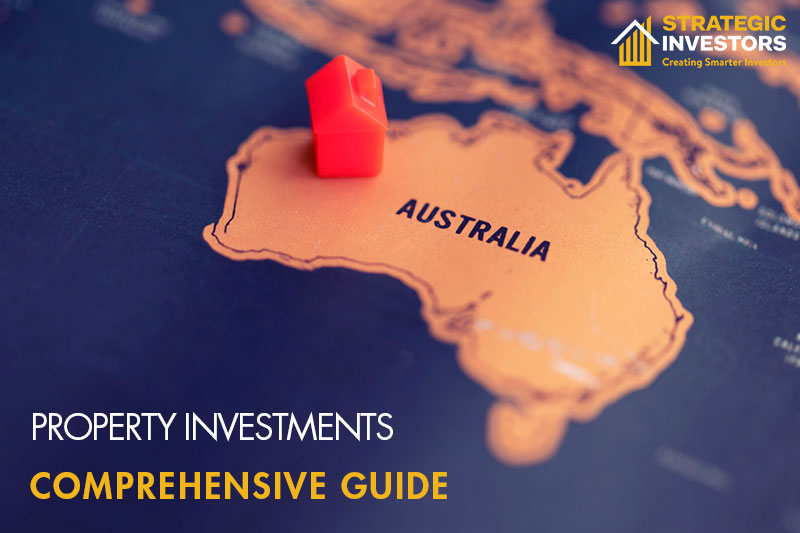
Are you ready to unlock the potential of property investments Australia? As the world’s sixth-largest country, the Australian property market offers a wealth of opportunities for savvy investors. This comprehensive guide will take you on an in-depth journey into the world of property investment, from understanding the market dynamics and property types to financing options and working with professionals. You’ll also learn about the tax implications and benefits, as well as the risks and challenges associated with property investments Australia.
By the end of this guide, you’ll be well-equipped to navigate the property investment landscape and make informed decisions to grow your wealth.
Key Takeaways
- Understand the key factors that influence the Australian property market to make informed investment decisions.
- Invest in residential, commercial and industrial properties while considering risks and rewards associated with each type of asset class.
- Stay informed about market trends, tenant relationships and tax implications to effectively manage potential losses from investing in property.
Understanding the Australian Property Market
 Investing in property in Australia can be a rewarding journey, but it’s essential to grasp the factors that influence the property market. Some key factors to consider include:
Investing in property in Australia can be a rewarding journey, but it’s essential to grasp the factors that influence the property market. Some key factors to consider include:
- Population growth
- Urbanization
- Economic factors
- Employment opportunities
- Government policies and regulations
These factors all play a crucial role in shaping the market landscape. It’s important to consider these aspects when planning your property investment strategy, as they can significantly impact property values, rental income, and capital growth.
Population Growth and Urbanization
With an annual population growth rate of 2.2% and a trend of increasing urbanization, Australia is experiencing a surge in demand for housing. This demand, particularly in capital cities and coastal areas, drives property prices and creates a robust property market. However, regional areas may experience underperforming property values due to a lack of attention.
Understanding the effects of population growth on the property market empowers you to make informed decisions and target areas with robust growth potential.
Economic Factors and Employment Opportunities
The economy and employment opportunities play a significant role in shaping property investment decisions. Areas with a strong job market attract more tenants and potential buyers, influencing property values and rental demand. Key economic factors, such as interest rates, economic growth, and income levels, also impact the property market.
Staying informed about economic conditions and the job market equips you to make more prudent property investment choices and enhance your returns.
Government Policies and Regulations
Government policies and regulations, such as tax incentives, zoning laws, and infrastructure development, can affect property investments. For example, zoning laws may impact property values by dictating the types of development permitted on the land, while infrastructure projects can increase land values for properties that benefit from these upgrades.
Staying abreast of government policies and regulations is vital in order to capitalize on potential benefits and sidestep any pitfalls in the property investment landscape.
Types of Property Investments in Australia
 When it comes to property investments in Australia, you have several options to choose from, including residential, commercial, and industrial properties. Each type offers unique characteristics and potential returns. Grasping the differences between these property types, as well as the potential risks and rewards associated with each, is necessary for making informed decisions and augmenting your returns.
When it comes to property investments in Australia, you have several options to choose from, including residential, commercial, and industrial properties. Each type offers unique characteristics and potential returns. Grasping the differences between these property types, as well as the potential risks and rewards associated with each, is necessary for making informed decisions and augmenting your returns.Residential Properties
Residential properties are a popular choice among investors due to their potential for capital growth and rental income. Whether you’re considering houses, apartments, or duplexes, residential properties offer a range of benefits for property investors. However, it’s important to consider factors such as maintenance costs, tenant demand, and the potential for capital growth when choosing a residential property.
When investing in residential properties, it’s crucial to select a property with strong tenant appeal, as this can help ensure consistent rental income and cash flow. Additionally, properties with potential for value-add, such as those that can be renovated or developed, can offer higher capital growth prospects. By carefully selecting residential properties that align with your investment goals, you can maximize your returns and minimize risks.
Commercial Properties
Commercial properties, such as retail spaces, offices, and warehouses, can offer investors higher rental yields compared to residential properties. However, investing in commercial properties may require a larger initial investment and specialized knowledge of the commercial property market. It’s important to weigh the potential rewards against the risks and consider working with a professional real estate agent to help you navigate the commercial property landscape.
Industrial Properties
Industrial properties, such as factories and distribution centers, can provide investors with stable, long-term income. Like commercial properties, industrial properties may require a higher initial investment and specialized knowledge to manage effectively.
Weighing the potential risks and rewards associated with industrial properties will enable you to make well-informed decisions that align with your investment goals.
Financing Your Property Investment
 Financing your property investment in Australia can involve various options, including traditional mortgages, investment loans, and leveraging equity from existing properties. Comprehending the differences between these financing options and picking the most suitable one for your needs can have a significant impact on your investment’s success and long-term growth potential.
Financing your property investment in Australia can involve various options, including traditional mortgages, investment loans, and leveraging equity from existing properties. Comprehending the differences between these financing options and picking the most suitable one for your needs can have a significant impact on your investment’s success and long-term growth potential.
Traditional Mortgages
Traditional mortgages are commonly used for purchasing residential properties in Australia. These loans are offered by banks and other financial institutions and usually have a term of 30 years. Interest rates can be fixed or variable, and the required deposit can range from 5% to 20% or more of the property value.
It’s important to consider factors such as interest rates, loan terms, and deposit requirements when selecting a traditional mortgage for your property investment.
Investment Loans
 Investment loans are specifically designed for property investors and may have different terms and conditions compared to traditional mortgages. These loans often require a higher deposit and may have higher interest rates due to the increased risk associated with investment properties.
Investment loans are specifically designed for property investors and may have different terms and conditions compared to traditional mortgages. These loans often require a higher deposit and may have higher interest rates due to the increased risk associated with investment properties.
When considering an investment loan, it’s essential to weigh the potential benefits and drawbacks and consult with a financial advisor to determine the best option for your investment strategy.
Leveraging Equity
Leveraging equity from existing properties can help investors expand their portfolios without additional cash deposits. By refinancing or creating a cash-out loan, you can use the equity in your current property as a deposit for an investment property. This strategy allows you to tap into the value of your existing assets and potentially increase your investment returns.
However, it’s crucial to understand the risks associated with leveraging equity and consult with a financial advisor to determine if this strategy is suitable for your financial goals.
Finding the Right Investment Property

Location Selection
Location selection is crucial for property investment success, as it impacts demand, rental income, and capital growth. When selecting a location for your investment property, consider factors such as property growth cycles, tenant preferences, and proximity to services, transportation, and job opportunities.
Choosing a location with robust growth potential and high tenant appeal will help maximize your rental income and capital growth prospects
Property Type Considerations
When selecting a property type for your investment, consider factors such as maintenance costs, tenant demand, and potential for capital growth. Different property types, such as houses, apartments, and commercial properties, may have varying rental yields and potential for capital growth. For instance, houses may have higher potential for capital growth, while apartments may have higher rental yields. By carefully considering property types and their associated factors, you can make informed decisions that align with your investment goals.
Assessing Rental Income and Capital Growth Potential
Assessing the potential rental income and capital growth of your investment property can help you make informed decisions and maximize your returns. Consider factors such as property values, location, and market conditions when evaluating rental income and capital growth potential.
A thorough analysis of these factors will enable you to select properties that are likely to generate strong rental income and capital growth, ensuring the success of your property investment.
Building a Property Investment Portfolio
 Building a successful property investment portfolio involves diversification strategies, balancing risk and reward, and monitoring and adjusting the portfolio as needed. Implementing these strategies will help manage market fluctuations, minimize potential losses, and optimize your investment returns.
Building a successful property investment portfolio involves diversification strategies, balancing risk and reward, and monitoring and adjusting the portfolio as needed. Implementing these strategies will help manage market fluctuations, minimize potential losses, and optimize your investment returns.Diversification Strategies
Diversification strategies can help investors spread risk across different property types and locations. By investing in a mix of properties, such as residential, commercial, and industrial, as well as properties in different regions or cities, you can reduce your overall risk exposure and achieve more consistent returns.
Additionally, diversifying across other asset classes, such as stocks and bonds, can further mitigate risks and enhance your investment portfolio’s stability.
Balancing Risk and Reward
Balancing risk and reward is essential for long-term property investment success. By diversifying your portfolio, conducting thorough research, setting realistic expectations, and staying informed about market trends, you can effectively manage risk and maximize your investment returns.
Additionally, working with professionals such as real estate agents, property managers, and financial advisors can help you navigate the property investment landscape and make informed decisions with their property investment advice.
Monitoring and Adjusting Your Portfolio
Regularly monitoring and adjusting your property investment portfolio is crucial to ensure that your investments remain aligned with your financial goals and market conditions. Reviewing your portfolio annually will enable you to identify areas that require adjustments, such as underperforming properties or markets experiencing significant changes.
This proactive approach can help you stay ahead of market trends and maintain a successful property investment portfolio.
Working with Professionals
 Working with professionals such as real estate agents, property managers, and financial advisors can help investors navigate the property investment process and maximize returns. These professionals offer valuable market insights, assist with property selection and negotiation, and provide guidance on investment strategies and portfolio management.
Working with professionals such as real estate agents, property managers, and financial advisors can help investors navigate the property investment process and maximize returns. These professionals offer valuable market insights, assist with property selection and negotiation, and provide guidance on investment strategies and portfolio management.Real Estate Agents
Real estate agents can provide valuable services such as:
- Providing market insights
- Assisting with property selection
- Assisting with negotiation
- Sharing knowledge of market trends, property values, and potential investment opportunities
- Acting as a mediator during negotiations to achieve the best possible outcome for your investment.
Working with a professional real estate agent can help you make informed decisions and maximize your investment potential.
Property Managers
Property managers can handle tenant-related issues, maintenance, and rent collection, allowing investors to focus on growing their portfolios. Hiring a professional property manager will ensure that your rental properties are well-maintained, tenants are satisfied, and rental income is consistently collected.
This can help you maximize your rental income and achieve long-term success in property investment.
Financial Advisors
Financial advisors can offer guidance on investment strategies, tax implications, and portfolio management. Working with a financial advisor will give you a deeper understanding of your financial goals and the best strategies to achieve them.
Financial advisors can also help you navigate the complex world of tax implications, legal fees, and benefits associated with property investment, ensuring that you maximize your returns and minimize your tax liability.
Tax Implications and Benefits of Property Investment
 Tax implications and benefits of property investment in Australia include income tax, capital gains tax, and various tax deductions and benefits. Understanding these tax implications and benefits can help you make informed investment decisions and maximize your returns.
Tax implications and benefits of property investment in Australia include income tax, capital gains tax, and various tax deductions and benefits. Understanding these tax implications and benefits can help you make informed investment decisions and maximize your returns.Income Tax
Income tax, including land tax, applies to rental income generated from investment properties in Australia. The amount of tax owed depends on your marginal tax rate, which ranges from 0% for income up to $18,200 to 45% for income over $180,000. Understanding the income tax rates and accurately reporting your rental income can ensure compliance with tax regulations and avoid potential penalties.
Capital Gains Tax
Capital gains tax is payable on the profit made from selling an investment property. In Australia, if you have owned the property for at least 12 months before selling it, you may be eligible for a 50% capital gains tax discount. This means that only half of the capital gain will be subject to taxation, potentially reducing your overall tax liability.
Tax Benefits and Deductions
Tax benefits and deductions, such as negative gearing and depreciation, can help investors reduce their overall tax liability. Negative gearing allows investors to deduct property-related borrowing and maintenance expenses from their gross income, reducing the amount of tax they owe on their other income. Depreciation is a tax deduction that allows investors to claim a portion of the cost of an investment property as a tax deduction, further reducing their tax liability.
Taking advantage of these tax benefits and deductions can help maximize investment returns and reduce your tax burden.
Risks and Challenges of Property Investment
 Investing in property comes with its share of risks and challenges, such as:
Investing in property comes with its share of risks and challenges, such as:
- Market fluctuations
- Vacancies and tenant issues
- Maintenance, repair costs, ongoing costs, and other costs involved
- Financing and interest rate risks
- Regulatory and legal risks
By understanding these risks and challenges, you can make informed decisions and mitigate potential losses in your property investments.
Market fluctuations can affect property values and rental demand, making it essential for investors to stay informed and adapt their strategies accordingly. Economic factors, such as interest rates, employment levels, and household debt, can influence property values and rental income. Staying abreast of market trends and adjusting your investment strategy as necessary will allow you to navigate market fluctuations and maintain a successful property investment portfolio.
Market Fluctuations
Market fluctuations can affect property values and rental demand, making it essential for investors to stay informed and adapt their strategies accordingly. Economic factors, such as interest rates, employment levels, and household debt, can influence property values and rental income.
Staying abreast of market trends and adjusting your investment strategy as necessary will allow you to navigate market fluctuations and maintain a successful property investment portfolio.
Vacancies and Tenant Issues
Vacancies and tenant issues can impact rental income and cash flow, making it crucial for investors to select properties with strong tenant appeal and manage tenant relationships effectively. Maintaining a professional and courteous relationship with tenants and promptly addressing their concerns can help minimize vacancies and ensure a consistent rental income.
Additionally, working with a professional property manager can help you handle tenant-related issues, maintain a successful rental property investment, and navigate property management fees.
Summary
In conclusion, property investment in Australia offers a wealth of opportunities for those willing to navigate the complexities of the market. By understanding the factors that influence the property market, selecting the right property type and location, financing your investment wisely, and working with professionals, you can maximize your returns and build a successful property investment portfolio. Don’t forget to stay informed about market trends and adapt your strategies as needed, as this will help you navigate the risks and challenges of property investment and achieve long-term success.
Frequently Asked Questions














